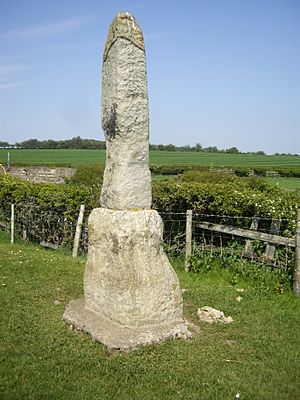Legs Cross facts for kids
Legs Cross is an ancient stone cross from Anglo-Saxon times. It stands near the village of Bolam in County Durham, England. You can find it about 4 miles (6.4 km) north of Piercebridge. It's located on an old route called the Pilgrims' Way, which follows part of the ancient Roman road known as Dere Street. This cross is a very important historical site and is protected by law as a Grade II* listed structure and an ancient monument.
Contents
What is Legs Cross?
Legs Cross is a special stone monument from the Anglo-Saxon period. This was a time in English history between the 5th and 11th centuries. These crosses were often used as markers, memorials, or places for people to gather and pray.
When Was Legs Cross Built?
Experts believe Legs Cross was probably built in the 9th century. This means it was created sometime in the 800s, over 1,100 years ago!
What Does Legs Cross Look Like?
Today, Legs Cross looks like a tall, thin stone pillar. It is made of sandstone. The cross is about 2.6 meters (8.5 feet) high. It stands on a base that is shaped like a triangle. Over many centuries, the stone has worn away. But you can still see some cool woven patterns carved into its sides. These patterns are typical of Anglo-Saxon art.
How Did Legs Cross Get Its Name?
The name "Legs Cross" has a few interesting theories behind it.
The Roman Legion Theory
One idea is that the cross once had the letters "LEG" carved into it. This might have been short for "LEGIONIS," which means "of the legion" in Latin. Nearby Piercebridge was once a Roman fort. So, some people think the cross might have been made from old Roman stones. It could have been built to celebrate the 20th Legion, a famous Roman army group.
The Boundary Theory
Another theory suggests the name comes from an old Anglo-Saxon word. The word "legge" meant "boundary." So, the cross might have marked an important border between different lands or areas.
The King James Theory
A fun story says that King James VI of Scotland (who later became King James I of England) once rested here. He was on his way south to become the new king of England. The story says he sat with his legs crossed at this spot. While this is a popular tale, it's probably not the real reason for the cross's name.


